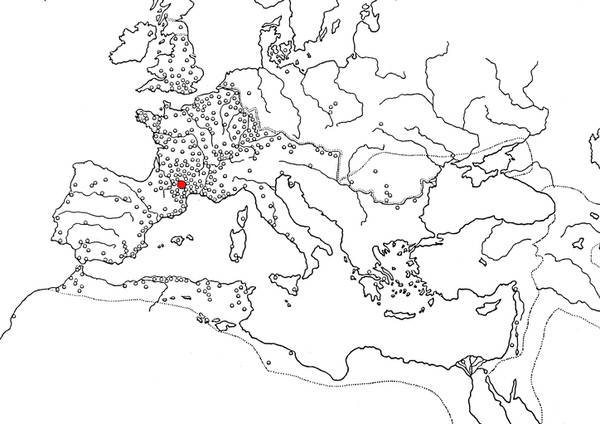Plate in South-Gaulish Samian ware style
During the 1st century A.D., southern France experienced a surge in pottery workshops that imitated the Italic red gloss “sigillata” ware, initially made in Arezzo and then in Pisa.
These workshops made items for the continental European market, and only products from the La Graufesenque group, near the current town of Milau, were also distributed around the Mediterranean (fig. 1).

Between 40 and 70/80 A.D., an unknown workshop in this group gave birth to the idea of an unusual type of decoration of crocks: the surface was no longer coated with the usual red gloss paint, but was given a “marbled” effect, where red and yellow merged together to create a special effect.
We do not know the reason behind the making of these pieces, which only lasted for a generation, and were then abandoned, as, in the contexts that have been excavated, we find them together with other earthenware from the same workshop, with no distinction made.
The most probably hypothesis is that the effect was an accidental result of some problem in kilning the ware and then reproduced on purpose, without a specific meaning, but just for its appearance.
The plate, that probably comes from a tomb given its excellent state of preservation (figs. 2-4) is an excellent example of marbled crockery. It has a simple, functional shape, with a low base, a short oblique wall, and the flat bowl, that is raised internally in the centre, where the illegible manufacturer’s stamp can be seen.



The shape of the vase is canonical, for both Italic red gloss sigillata ware and south-Gaulish samian ware and is off the Dragendorff type 18 (fig. 5).

In Sardinia, the South-Gaulish in general, and therefore also marbled work was rather widespread (even if not shown in the map in fig. 1, which is not updated with the most recent data) and mainly characterises the levels of life in the second half of the 1st and the first decades of the 2nd century A.D.
Bibliografia
- C. BEMONT, J.-P. JACOB (edd.), La terre sigillée gallo-romaine, Paris 1986, pp. 96-103.
- J. W. HAYES, Roman Pottery. Fine-ware Imports, (= Athenian Agorà XXXII), Princeton 2008, p. 47.
- C. TRONCHETTI, La ceramica della Sardegna romana, Milano 1996, pp. 65-69.

 VR
VR